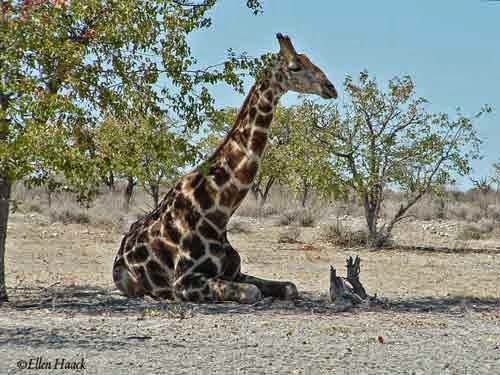Ellen’s previous guest posts were travelogues of Viet Nam’s Mekong Delta and New Zealand’s South Island (see P.S. for links). As for Africa, Ellen and Barry spent two years in Kenya and a year in Tanzania, where Barry was employed or on sabbatical. Barry has also had projects in Sudan, Ethiopia, Mozambique, Swaziland, Zambia and Malawi, with stays in Egypt and South Africa.
For the travelogue that begins today and continues next Tuesday, Ellen and Barry recently spent two weeks driving through Namibia.
 |
| Namibia in southwestern Africa; about twice the size of California with only 2.3 million people. (www.africanwildlifesafaris.com.au) |
We began our tour in the capital, Windhoek. Too late to line up a 4-wheel drive vehicle, we rented a Toyota Corolla and drove north about 260 miles to Etosha National Park.
Etosha National Park
The travel literature presents Etosha, 8,600 square miles, as one of Africa's top parks for wildlife, but we were prepared to be disappointed. We had been in the great wildlife parks of East Africa and were convinced that the semi-desert environment couldn't possibly support the same abundance of animals. We were thrilled to be wrong. Here’s a sample of what we saw while driving through the park.
 |
| Lions relaxing or maybe digesting an impala that didn’t make it to the tree line. |
 |
| Zebra stopping traffic on a park road. |
 |
| A too-close-for-comfort elephant encounter. |
 |
| This elephant obviously found mud to roll in. |
 |
| Even impala seek shade. |
 |
| As do giraffes, though they have to duck down. |
 |
| Gnu (wildebeest), impala and ostrich at a waterhole. |
 |
| Jackals prefer to be alone. |
 |
| A communal nest of sociable weaver birds. These gigantic nests sometimes house several hundred birds and can be occupied for close to 100 years. |
We’ll stop here for the day, let the Haacks head for a rest camp by a waterhole, and continue next Tuesday. Thanks for stopping by.
P.S.
Ellen Haack’s earlier travelogue posts on the Retired—Now What? Blog:
Mekong Delta—Life on the Water
Part 1: www.retired--nowwhat.com/2012/04/mekong-delta-life-on-water-part-1.html
Part 2: www.retired--nowwhat.com/2012/04/mekong-delta-life-on-water-part-2.html
A New Zealand Journey
Part 1: www.retired--nowwhat.com/2013/04/a-new-zealand-journey-part-1.html
Part 2: www.retired--nowwhat.com/2013/04/a-new-zealand-journey-part-2.html


No comments:
Post a Comment